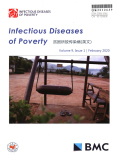- 钛学术文献服务平台 \
- 学术期刊 \
- 医药卫生期刊 \
- 内科学期刊 \
- 贫困所致传染病(英文)期刊 \
Demand for longer quarantine period among common and uncommon COVID-19 infections: a scoping review
Demand for longer quarantine period among common and uncommon COVID-19 infections: a scoping review
基本信息来源于合作网站,原文需代理用户跳转至来源网站获取
摘要:
Background::As one of the non-pharmacological interventions to control the transmission of COVID-19, determining the quarantine duration is mainly based on the accurate estimates of the incubation period. However, patients with coarse information of the exposure date, as well as infections other than the symptomatic, were not taken into account in previously published studies. Thus, by using the statistical method dealing with the interval-censored data, we assessed the quarantine duration for both common and uncommon infections. The latter type includes the presymptomatic, the asymptomatic and the recurrent test positive patients.Methods::As of 10 December 2020, information on cases have been collected from the English and Chinese databases, including Pubmed, Google scholar, CNKI (China National Knowledge Infrastructure) and Wanfang. Official websites and medias were also searched as data sources. All data were transformed into doubly interval-censored and the accelerated failure time model was applied. By estimating the incubation period and the time-to-event distribution of worldwide COVID-19 patients, we obtain the large percentiles for determining and suggesting the quarantine policies. For symptomatic and presymptomatic COVID-19 patients, the incubation time is the duration from exposure to symptom onset. For the asymptomatic, we substitute the date of first positive result of nucleic acid testing for that of symptom onset. Furthermore, the time from hospital discharge or getting negative test result to the positive recurrence has been calculated for recurrent positive patients.Results::A total of 1920 laboratory confirmed COVID-19 cases were included. Among all uncommon infections, 34.1% (
n = 55) of them developed symptoms or were identified beyond fourteen days. Based on all collected cases, the 95th and 99th percentiles were estimated to be 16.2 days (95%
CI 15.5-17.0) and 22.9 days (21.7-24.3) respectively. Besides, we got similar estimates based on merely symptomatic and presymptomatic infections as 15.1 days (14.4-15.7) and 21.1 days (20.0-22.2).
Conclusions::There are a certain number of infected people who require longer quarantine duration. Our findings well support the current practice of the extended active monitoring. To further prevent possible transmissions induced and facilitated by such infectious outliers after the 14-days quarantine, properly prolonging the quarantine duration could be prudent for high-risk scenarios and in regions with insufficient test resources.

推荐文章
COVID-19临床资料分析
新型冠状病毒
感染
新型冠状病毒性肺炎
COVID-19疫情下方舱CT的紧急建设
新型冠状病毒肺炎
方舱CT
辐射防护
CT质量控制
儿童COVID-19的流行病学与临床诊疗特点
新型冠状病毒肺炎
儿童
流行病学
诊断治疗
COVID-19合并肺血栓栓塞症的临床特点
新型冠状病毒肺炎
新型冠状病毒
肺栓塞
预后
内容分析
关键词云
关键词热度
相关文献总数
(/次)
(/年)
文献信息
| 篇名 | Demand for longer quarantine period among common and uncommon COVID-19 infections: a scoping review | ||
| 来源期刊 | 贫困所致传染病(英文) | 学科 | |
| 关键词 | COVID-19 Quarantine duration Incubation period Asymptomatic infections Presymptomatic infection Recurrent positive | ||
| 年,卷(期) | 2021,(2) | 所属期刊栏目 | Scoping Review |
| 研究方向 | 页码范围 | 5-13 | |
| 页数 | 9页 | 分类号 | |
| 字数 | 语种 | 中文 | |
| DOI | 10.1186/s40249-021-00847-y | ||
五维指标
引文网络
引文网络
二级参考文献 (0)
共引文献 (0)
参考文献 (6)
节点文献
引证文献 (0)
同被引文献 (0)
二级引证文献 (0)
2009(2)
- 参考文献(2)
- 二级参考文献(0)
2018(1)
- 参考文献(1)
- 二级参考文献(0)
2020(3)
- 参考文献(3)
- 二级参考文献(0)
2021(0)
- 参考文献(0)
- 二级参考文献(0)
- 引证文献(0)
- 二级引证文献(0)
研究主题发展历程
节点文献
COVID-19
Quarantine duration
Incubation period
Asymptomatic infections
Presymptomatic infection
Recurrent positive
研究起点
研究来源
研究分支
研究去脉
引文网络交叉学科
相关学者/机构
期刊影响力
贫困所致传染病(英文)
主办单位:
中华医学会
出版周期:
双月刊
ISSN:
2095-5162
CN:
10-1399/R
开本:
出版地:
上海市黄浦区瑞金二路207号
邮发代号:
创刊时间:
2016
语种:
eng
出版文献量(篇)
434
总下载数(次)
0
总被引数(次)
45
期刊文献
相关文献
推荐文献
- 期刊分类
- 期刊(年)
- 期刊(期)
- 期刊推荐

 免费查重
免费查重










